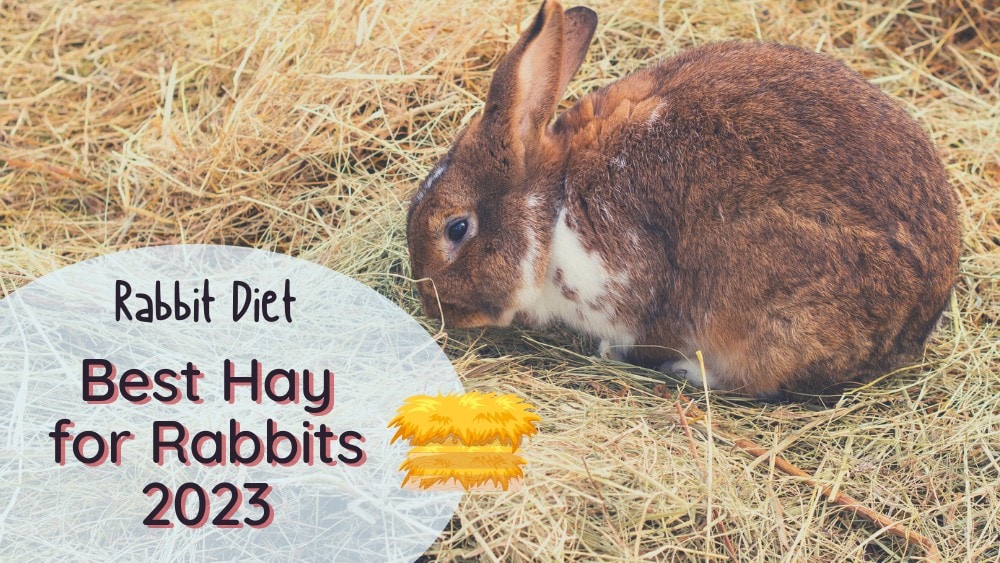If you want to jump down a rabbit hole, start researching the best hay for rabbits. There are close to a dozen different grasses, legumes, and hay blends that are dried and marketed to rabbit owners, all with different nutritional values. To make it more complicated, the first harvest of a hay crop each season has different composition and nutrition than the second and third cutting of the same crop!
How do you know which of these options will keep your rabbit in the best of health? In this review, we’ll cover the different types of hay, chart their nutrients, and answer the following questions.
- What’s the difference between timothy hay, orchard hay, or oat hay?
- Is timothy or alfalfa better for rabbits?
- How much protein and fiber does each hay contain?
- Is first or second-cutting hay better for bunnies?
We’ll also showcase our favorite hay products for rabbits, and give some tips on how to find high-quality hay at the best price.
What is the Best Hay for Rabbits?
Most veterinarians – including Dr. Kathryn Dench DVM, the vet here on the Fuzzy-Rabbit.com team – recommend grass hay for rabbits. Timothy is the best-known hay and a great all-around choice for bunnies. Other suitable options include oat hay, orchard hay, and brome. Alfalfa hay is too high in protein and calcium for adult rabbits to eat regularly.
My rabbits thrive on Small Pet Select’s big box of Second Cutting Timothy Hay.
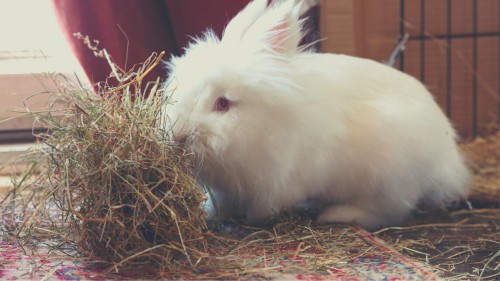
Best Hay For Rabbits 2023 – Small Pet Select Second Cutting Timothy

| Star Rating: | 4.5⭐ |
| Species: | 2nd Cutting Timothy |
| Best for: | Rabbits in all stages of life |
The name of this product is a little confusing. Even though it’s called a “Timothy blend,” this product is actually 100% high-quality second cutting timothy hay. What the manufacturer means by “blend” is that it has a balanced ratio of stems, leaves, and seed heads – so your bunnies will consider it delicious!
What We Like
- Hand-packed bags to reduce crushing and dust.
- 2nd-cutting timothy has a ratio of fiber and protein content that’s perfect for most rabbits.
- Fresh, green, and carefully dried to preserve nutrients.
- Available in a range of sizes from 12 oz to 40 pounds!

What We Don’t Like
- Some rabbits don’t prefer the longer strands of this hay.
- No plastic bag within the box, so it’s eco-friendly but difficult to store.
- US-grown and not available in some parts of the world.
- Not as many seed heads as first cutting (some bunnies love them!)
Best Organic Hay – Small Pet Select Organic Timothy Hay

| Star Rating: | 3.5⭐ |
| Species: | Organic Timothy – Cutting can vary |
| Best for: | Rabbits in all stages of life |
Small Pet Select is famous for its top quality rabbit hays, and less than a year ago released a new, hard-to-find-elsewhere product: organic timothy hay. Grown without pesticides, this organic hay is great for sensitive bunnies that may react to chemicals in their diets.
But is this product really better for rabbits than regular timothy hay? For one thing, the claim that this hay is non-GMO doesn’t set it apart; no timothy or grass hay is genetically modified. This product also doesn’t specify whether it’s first, second, or third cutting – so you won’t know what to expect with each bag.
What We Like
- Assurance that it’s grown without pesticides.
- Timothy hay is great for rabbits’ gut and dental health.
- Minimally handled during packaging – no machine grease or damage.

What We Don’t Like
- Not available in as many sizes as other varieties of timothy.
- First and second cuttings are mixed.
- Strong smell compared to other timothy hays.
- Does not appear to be certified organic, but rather grown using organic farming practices.
- More expensive than regular timothy hay.
Most Affordable Hay for Rabbits – Vitakraft Premium Timothy Hay

| Star Rating: | 4.0⭐ |
| Species: | Timothy – |
| Best for: | Rabbits in all stages of life |
Vitakraft Premium Timothy Hay is, in my experience, just as good as the organic option listed above – at a much lower price tag! While the manufacturer doesn’t claim that it’s organic, they do say that it’s sun-dried and grown without pesticides – so it should be chemical-free. I love the semi-compressed “mini bale” packaging, since I can easily break off a flake for each rabbit. My only concern is that it sometimes doesn’t seem quite as fresh as the Small Pet Select 2nd cutting hay.
What We Like
- Timothy hay is a wonderfully balanced food staple for rabbits.
- Affordable compared to other brands, especially in the small bag size.
- Sun-dried, American-grown, and free of pesticides.
- “Mini bale” semi-compression makes it easy to feed.

What We Don’t Like
- You can’t choose whether you get first or second cutting.
- Compression into mini-bales can cause some breakage and dust.
- Occasionally you get a bag that’s less fresh than other brands.
Best Hay for Rabbits with Allergies – Small Pet Select Orchard Grass

| Star Rating: | 4.5⭐ |
| Species: | Timothy |
| Best for: | Rabbits in all stages of life |
Timothy hay is very high fiber, so it can tend to be stiff and dry. While that’s great for dental health, some bunnies aren’t fond of the texture. Dryness can also lead to dust and irritation in some rabbits. If you find your rabbit doesn’t like Timothy or is allergic to it, orchard grass is a wonderful alternative.
Orchard grass hay is slightly higher in protein and energy than timothy. If you give your bunny orchard hay, keep its treats and other starchy foods to a minimum. You should also make sure it has safe chew toys to keep its teeth worn down correctly.
What We Like
- Sweeter and softer than timothy hay.
- Wonderful fresh smell!
- Long strands with very little breakage.
- Less dust than Timothy.
- Eco-friendly: grown with less water than Timothy.

What We Don’t Like
- Lower stem, so not as high in fiber as other grass.
- No seed heads.
- Loose hay in the box can make a mess.
- Rabbits may get picky and not want to eat Timothy after this!
Best Hay for Picky Rabbits – Oxbow Botanical and Oat Hay Bundle
| Star Rating: | 5.0⭐ |
| Species: | Timothy, Oat, and herbs |
| Best for: | Rabbits in all stages of life |
I love to give my rabbits a variety of hays to choose from, so I like the Oxbow Botanical Hay bundle with oat hay. Oat hay is similar in texture and nutrients to timothy and is one of the best options for rabbits’ dental health. The Oxbow Botanical blend has a timothy base with bunny-safe dried herbs like chamomile and lemon balm.
What We Like
- Oxbow hays are consistently top quality and freshness.
- Herbs like lavender, chamomile, lemon balm, and clover add trace nutrients.
- Oat hay takes a while to chew and keeps rabbits busy and happy.
- 100% organically grown according to the company.
What We Don’t Like
- Plastic packaging is less eco-friendly than a box.
- Small package size if you have multiple rabbits.
Best Alfalfa for Rabbits – High Desert Alfalfa Hay

| Star Rating: | 4.5⭐ |
| Species: | Alfalfa |
| Best for: | Rabbits in all stages of life |
While most pet rabbits shouldn’t have alfalfa, there are some times of growth and development when bunnies need extra protein. Rabbit owners are consistently pleased with the quality of High Desert Alfalfa hay when their bunnies need a boost in energy.
What We Like
- Company offers a 100% satisfaction guarantee.
- Very fresh US-grown product.
- Rich, green appearance.

What We Don’t Like
- Some commercially-grown alfalfa is genetically modified (GMO). It’s unclear as to whether this product is GMO or not.
- Too rich in protein, calories, and calcium for most adult rabbits.
- Very fragrant!
Best Compressed Hay for Rabbits – Oxbow Harvest Stacks
| Star Rating: | 4.5⭐ |
| Species: | Timothy |
| Best for: | Rabbits in all stages of life |
I love how hay smells. I love how nutritious it is for my bunnies. Honestly, though, I hate the mess it makes. When I’m traveling with my rabbits and can’t afford hay flying everywhere, I splurge on Oxbow Harvest Stacks.
Made of 100% western timothy, these compressed hay cubes have no fillers or binders – so they have the same nutritional value as regular timothy hay. They reduce airborne dust by 80% and definitely cut down on the explosion of hay scraps you find in any rabbit’s habitat.
What We Like
- Made of 100% hay — no binders or filler ingredients.
- Very simple rationing – one “stacker” per bunny twice a day.
- So much less mess and dust.
What We Don’t Like
- Not as entertaining for rabbits as regular hay.
- Doesn’t have the same dental benefits.
- Expensive compared to regular hay.
How to Choose the Best Hay for Rabbits
Veterinarians and seasoned rabbit owners agree: healthy bunnies eat mostly hay. Hay reflects a rabbit’s natural diet since hay is simply dried grass. Hay is tall grass that’s cut when green and just starting to flower, so it’s rich in nutrients. (This is in contrast to straw, which is the low-nutrient stems of cereal grasses cut after the plant has produced grain and finished its lifecycle.)
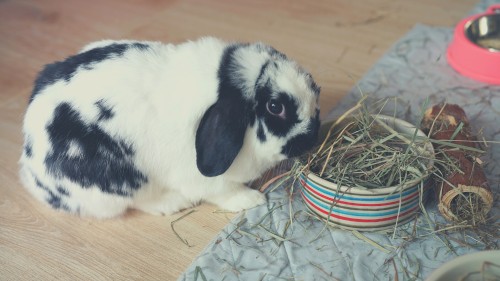
Hay can be made from a vast number of grass and legume species. As a general rule, grass hay is high in fiber and low in protein and energy. Alfalfa or legume hay has more protein and energy at the cost of less fiber. Different bunnies have different nutritional requirements and should eat different types of hay.
Hay for Baby Rabbits (3-12 weeks)
Baby rabbits are those from 3 weeks of age when they start to eat solid food to 12 weeks when they are fully weaned. They need very high-fiber diets to help them develop the right gut bacteria as they transition away from their mothers’ milk.
High protein, high-energy hays like alfalfa increase their risk of fatal enterotoxemia.
Young, Growing Rabbits (3 – 8 months)
Once a rabbit’s digestive system is used to eating solid foods, you can add some alfalfa or legume hay to give growing rabbits the energy and minerals they burn so quickly. Still, alfalfa and legume species should never make up more than 25% of a rabbit’s hay intake.
If you see red urine, a marked increase in urine, or calcium deposits in your bunny’s urine, decrease or quit legume hay altogether.
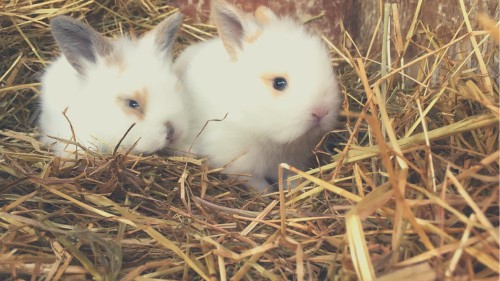
Adult Rabbits (6-12 months and up)
Depending on the breed, rabbits are fully grown between 6 and 12 months of age. Once they have reached full size, their metabolism settles down and they don’t need high-energy alfalfa hay.
Following the guidance of your veterinarian, transition your rabbit to 90-100% grass hay, served with fresh veggies and a daily teaspoon of pellets. You can choose whatever grass hay your rabbit likes best – be it timothy, orchard grass, oat grass, or a blend.
Pregnant and Lactating Rabbits
The only time adult rabbits may need more protein or energy is when they are pregnant or nursing a litter.
When mother rabbits don’t have enough protein, it makes them more likely to cannibalize their litter or have other reproductive problems.
Pregnant and lactating rabbits should get some supplemental alfalfa hay. But they still need very high fiber diets, so continue with grass hay as well.
What’s the best type of hay for rabbits?
There are three main categories of hay crops: grass hays, cereal hays, and legume hays. Some hay blends contain dried herbs as well.
Rabbits are persnickety. They can become set in their ways and only prefer one particular crop. I like to head this off by offering my rabbits a variety of grass, cereal, and herbal hays to get them used to different kinds.
Grass Hays
Timothy Hay Nutrients
Timothy hay (species Phleum pratense) is most commonly recommended for rabbits. It has perfectly balanced ratios of calcium and phosphorus (2:1), so it’s unlikely to cause the kidney problems that plague pet rabbits. It has a very high fiber content (up to 32%) and low protein (around 8%). This makes it an ideal bunny food when paired with fresh vegetables.
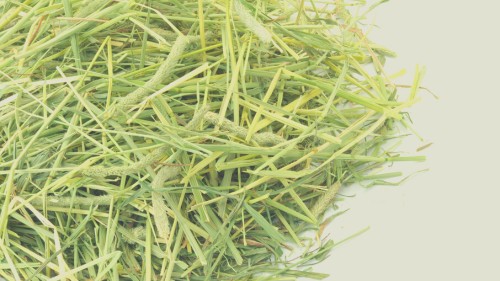
The main challenge with timothy hay is its availability. It requires more water to grow than some other species and is in high demand, so it can be expensive. In rare cases, bunnies seem to be allergic to it.
Orchard Grass Nutrients
Orchard grass, also known as cat grass or cocksfoot, is made from the grass species Dactylis glomerata.
It’s slightly higher in calories and protein than timothy hay (around 10% protein) and works well for young rabbits, high-energy bunnies, or elderly rabbits that need a bit richer feed. It also has a balanced calcium and phosphorus content – but it’s overall higher in calcium than timothy.
In taste and texture, it’s sweeter and softer than timothy hay – so once your bunnies taste orchard grass, they may not want to go back!
Farm Hays, Pasture Mixes, and Other Grass Hays
Timothy and orchard are the most popular grass hays that are commercially sold to pet rabbit owners. However, if you buy a bale of “hay” from a local farmer, it’s likely that it will be a “pasture mix” of a variety of different species. (Sometimes this is called “meadow hay.”)
Pasture mixes can be appropriate for rabbits, but make sure to ask what species the farmer planted. Meadow hay may include timothy and orchard grass, and it may also include species such as the following.
- Brome Grass
- Bermuda Grass
- Fescue
Hay from a local farmer may be cheaper than buying it bagged from Amazon or the pet store. It might also – maybe! – be fresher. However, in my experience, it’s more likely to be musty, dusty, or moldy from improper storage. It may also include weeds. Comb through your hay carefully before feeding it to your rabbits if you buy it from a local farm.
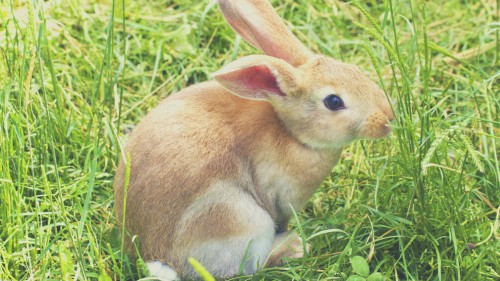
Cereal Grain Hays
Did you know that cereal grains like wheat, barley, and rye are in the grass family? Since they are actually grasses, all cereal grain hays are all healthy for rabbits when harvested green.
- Oat Hay
- Rye Grass
- Teff Hay
- Wheat Hay
Feel free to add green cereal hays to your rabbit’s diet free-choice. You only need to limit these hays if they were harvested later and include semi-mature seed heads. Mature grain seeds like oats and rye are fattening for rabbits. You should consider them treats or avoid them entirely.

Legume Hays
Alfalfa (known as lucerne in some areas) is the most common legume hay, followed by clover. Legume hays are dark green and fragrant, being much richer in protein, calories, and minerals than grass hays. Typically veterinarians recommend avoiding legume hays for adult pet rabbits, citing risks of obesity and kidney stones. Pregnant, growing, or elderly rabbits may need some legume hay to meet their extra energy needs.
First, Second, and Third-Cutting Hay
Depending on the growing climate, grass hay may be cut up to three times in a season. With each cutting, the ratio of leaves to stems increases.
- The first cutting of grass hay has the most stems – so it has higher fiber content and lower protein content.
- The second cutting of grass hay has balanced stems and leaves, and my bunnies prefer this texture.
- The third cutting, if there is one, is softest and typically higher in protein and energy than rabbits need.
Hay For Rabbits – Nutrient Chart
Here are the most common types of hay and their respective nutrient contents. As you can see, the nutrients in a crop vary widely depending on growing conditions, soil, plant stage at time of harvest and how it was dried. These ranges are based on data from feedipedia.org.
| Type of Hay | Protein (%) | Fiber (%) | Calcium (g/kg) |
|---|---|---|---|
| Alfalfa | 11 – 25 | 19 – 38 | 8.4 – 26.5 |
| Timothy | 6 – 14 | 25 – 40 | 0.3 – 5.0 |
| Orchard grass | 7 – 18 | 23 – 37 | 2.5 – 5.5 |
| Bermuda grass | 6 – 15 | 18 – 41 | 4.0 – 4.4 |
| Oat hay | 5 – 15 | 28 – 44 | 1.5 – 6.3 |
Frequently Asked Questions
Is Alfalfa or Timothy Better for Rabbits?
Grass hays like timothy are better for most rabbits. In fact, even rabbits who need some higher-energy alfalfa should also be eating a large amount of grass hay.
Can Rabbits Eat Fresh Grass Instead of Hay?
Yes, rabbits can eat fresh grass if it is free of pesticides and herbicides, but start small! If your bunny isn’t used to high-moisture grass, too much at once can upset its stomach. Wet grass will also mold quickly, so remove any uneaten portion from your rabbit’s habitat after a few hours. Lawn grass can also carry parasites or wild rabbit diseases. This is why I stick to hay for my bunnies.
How Much Hay Do Rabbits Eat?
It takes a 3-pound rabbit about a week to eat a pound of hay. This assumes that hay is 80% of a pet rabbit’s diet, as most vets recommend. Larger rabbits can eat two or three pounds of hay a week! Rabbits must have access to grass hay round-the-clock to prevent boredom and gastrointestinal stasis.
Conclusion
The standard for rabbit diets is second cutting timothy hay. Since it has a balanced ratio of stems and leaves, they can nibble on it happily all day without exceeding their caloric needs.
But if you have a fussy bunny, there are lots of wonderful grass hay and cereal grain hay options! I suggest trying the oat & botanical bundle in our list above, or the Small Pet Select Sampler pack with oat and orchard hays to see which one suits your bunny best.

What’s your rabbit’s favorite hay? Have you tried any new ones lately? Let us know in the comments!


